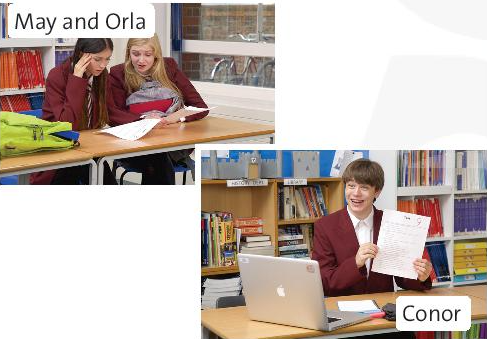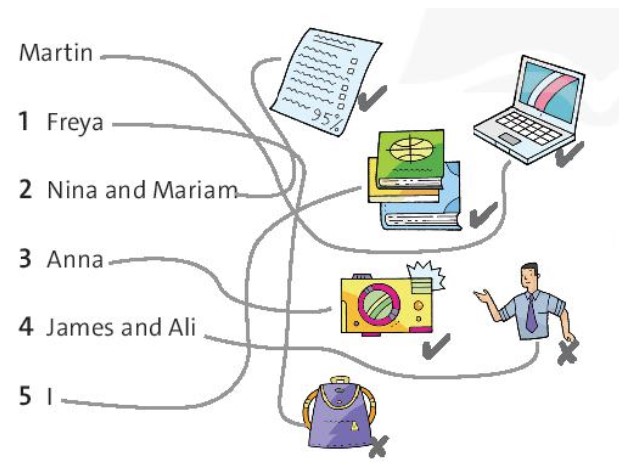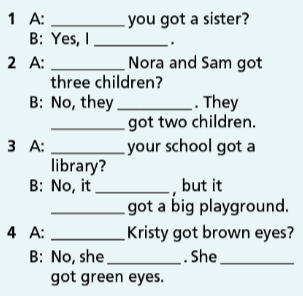3. Write the questions and answers using have got and the words.
(Sử dụng have got và các từ vựng được cho để viết các câu hỏi và câu trả lời.)
Ryan: Hello Tyler. Have you got your timetable (you/your timetable)?
Tyler: Yes, it’s tough! 1(I/two hours of history) on Monday. What 2(you)?
Ryan: 3(I/music).
Tyler: Cool. 4(you/Mr Wills) for music this year? He’s strict!
Ryan: No,5(I/a new teacher). 6(he/an Italian name) – Mr Moretti.
Tyler: Oh. 7(he/brown hair) and a blue jacket?
Ryan: Yes, he 8
Tyler: Oh, I know him. He looks nice.
Trong tiếng Anh, have got được dùng với nghĩa là “sở hữu, làm chủ, có,”.
Công thức:
Khẳng định: S + have/has got + objects
Phủ định: S + have/has + not + got + objects.
Nghi vấn:
What+have/has+S+got?
When/Where/Why/How/…+have/has+S+got+object?
Have/has + S + got + object?

Ryan: Hello Tyler. Have you got your timetable (you/your timetable)?
(Ryan: Chào Tyler. Bạn đã có thời khóa biểu chưa?)
Tyler: Yes, it’s tough! I ‘ve got two hours of history on Monday. Whathave you got?
(Tyler: Tớ nhận rồi, căng lắm! Tớ có hai giờ Lịch sử vào Thứ Hai. Bạn có môn gì?)
Giải thích: chủ ngữ “I” → sử dụng ‘ve got, chủ ngữ “you”, là câu hỏi → sử dụng have you got
Ryan: I’ve got music.
(Ryan: Tớ có tiết Âm nhạc.)
Giải thích: chủ ngữ “I” → sử dụng ‘ve got
Tyler: Cool. Have you got Mr Wills for music this year? He’s strict!
(Tyler: Tuyệt. Năm nay thầy Wills dạy bạn môn Âm nhạc à? Thầy ấy nghiêm khắc lắm.)
Giải thích: chủ ngữ “you”, là câu hỏi → sử dụng have you got
Ryan: No, I have got a new teacher. He’s got an Italian name – Mr Moretti.
(Ryan: Không, tớ có giáo viên mới. Thầy ấy có một cái tên đậm chất Ý – Thầy Moretti.)
Giải thích: chủ ngữ “I”, ngữ cảnh trong đề bài → sử dụng ‘ve got, chủ ngữ “he” → ‘s got
Tyler: Oh. Has he got brown hair and a blue jacket?
(Tyler: Oh. Có phải thầy ấy có tóc màu nâu và áo khoác màu xanh không?)
Giải thích:chủ ngữ “he”, là câu hỏi → Has he got
Ryan: Yes, he’s got.
(Ryan: Đúng vậy, là thầy ấy đấy.)
Giải thích:chủ ngữ “he”, là câu trả lời câu hỏi → he’s got
Tyler: Oh, I know him. He looks nice.
(Tyler: Oh, vậy thì tớ biết thầy ấy. Thầy ấy trông tuyệt đấy.)

Các bài tập cùng chuyên đề
have got
1. Look at the examples from the dialogue on page 8. What are the he / she / it forms of the words in bold?
(Nhìn vào các ví dụ từ đoạn hội thoại ở trang 8. Những từ in đậm có dạng gì khi đi với he / she / it?)
|
Affirmative (Khẳng định) 1. We’ve got maths now. (Bây giờ tôi có môn toán.) |
|
Negative (Phủ định) 2. I haven’t got my timetable. (Tôi không có thời gian biểu.) |
|
Questions (Câu hỏi) 3. What have we got now? (Bây giờ chúng ta có gì?) |
3. Write six questions with the correct forms of have got and the words in the boxes. Then work in pairs. Ask and answer your questions.
(Viết sáu câu hỏi với các dạng đúng của have got và các từ trong khung. Sau đó làm việc theo cặp. Hỏi và trả lời câu hỏi của bạn.)
|
you (bạn) your friends (bạn của em) your teacher (giáo viên của em) this class (lớp học này) the school (trường học) this book (quyển sách này)
|
interesting (thú vị) nice (tốt đẹp) good (tốt) difficult (khó) modern (hiện đại) old (cũ)
|
science lab (phòng thí nghiệm khoa học) marks (điểm) furniture (nội thất) classrooms (phòng học) exercises (bài tập) teachers (giáo viên) posters (áp phích) |
7. USE IT! Write a short paragraph (60-80 words) about your school using there’s, there are, has got and have got.
(THỰC HÀNH! Viết một đoạn văn ngắn (60-80 từ) về trường học của bạn bằng cách sử dụng there’s, there are, has got and have got.)
2. Look at the photos. Complete the sentences with the correct forms of have got.
(Nhìn vào những bức ảnh. Hoàn thành các câu với các dạng đúng của have got.)

May and Orla have got school ties. ✔
(May và Orla có cà vạt của trường.)
1. Conor ……………. a school tie. x
2. He……………. a laptop. ✔
3. May and Orla ……………. backpacks. ✔
4. They……………. laptops. x
5. They ……………. good marks. x
6. Conor……………. a very good mark. ✔
have got
a. Look at the family tree in Exercise 9 and fill each gap with have got, has got, haven’t got or hasn’t got.
(Nhìn vào “cây” gia đình trong bài tập 9 và điền vào chỗ trống với have got, has got, haven’t got hoặc hasn’t got.)
1. John and Kate __________ four children.
2. Nancy and Sam __________ a nephew, George, and a niece, Kristy.
3. Kristy __________ three cousins.
4. Mark __________ two brothers.
5. Sheila and Helen __________ a brother.
6. Peter __________ a brother.
b. Complete the questions, then answer them.
(Hoàn thành các câu hỏi, tiếp theo hãy trả lời chúng.)
1. ____ John ____ a wife? Yes, _________________________.
2. ____ Sam and Nancy ____ three children? ______________.
3. ____ Kim ______ two daughters? _____________________.
4. ____ John and Kate _______ four grandchildren? ________________________.
3. In pairs, use the Vocabulary box to tell your partner three things you have/haven’t got/would like to have.
(Làm việc theo cặp, dùng bảng Từ vựng để nói với bạn mình về ba thứ mà bạn có/không có/muốn có.)
I've got a bike. I haven’t got a guitar. I'd like to have a laptop.
(Tôi từng có một chiếc xe đạp. Tôi chưa từng có đàn ghi ta. Tôi muốn có một chiếc máy tính xách tay.)
1. Complete the table with the words.
(Điền các từ sau để hoàn thiện bảng.)
|
‘s got ‘ve got got Has has hasn’t hasn’t got have haven’t haven’t got |
|
Affirmative |
||
|
I/You/We/They He/She/It |
‘ve got 1 |
a new bag. |
|
Negative |
||
|
I/You/We/They He/She/It |
2 3 |
any books. |
|
Questions |
||
|
Have I/You/We/They 5……… he/she/it |
4 got |
any brothers? |
|
Short answers |
||
|
Affirmative Yes, I/you/we/they 6 Yes, he/she/it 7 |
Negative No, I/you/we/they8 No, he/she/it 9…….. |
|
2. Write sentences using the affirmative or negative form of have got.
(Viết các câu sử dụng thể khẳng định hoặc phủ định của have got.)
|
A camera a laptop a lot of books a new bag a new teacher good marks |

Martin ‘s got a laptop.
1 Freya
2 Nina and Mariam
3 Anna
4 James and Ali
5 I
have got (có)
8. Look at the family tree above and choose the correct option.
(Nhìn vào sơ đồ cây gia đình phía trên và chọn câu trả lời đúng.)
1. Have/Has Jane got a(n) brother/uncle?
Yes, she have/has. His name’s John
2. Have/Has Ted and Lisa got two sons/daughters?
Yes, they have/has. Their names are Sophie and Laura.
3. John haven’t got/hasn’t got a brother/sister.
4. Have/Has Derek got two brothers/cousins?
Yes, he has. Their names are Jane and John.
4. Make questions and sentences with have got.
(Đặt câu hỏi và câu với have got.)
1. I / two pets; I / a cat and a guinea pig /.
I’ve got two pets. I’ve got a cat and a guinea pig.
(Tôi có hai thú cưng. Tôi có một con mèo và một con chuột bạch.)
2. A: Your cousin / a car / ? B: No / he / not /.
3. We / not / a big house /.
4. A: You / a sister / ? B: yes / I
5. Our teacher / a dog; He / short legs /.
6. Linh and Bình / not / a cousin /.
2. Look at the pictures and complete the sentences.
(Nhìn vào bức tranh và hoàn thành câu.)

I’ve got trainers, ___ I’ve got a dictionary, ___,
and ___. and ___ on my ___.
Have got
5. Order the words to make sentences or questions.
(Sắp xếp các từ sau thành một câu hoặc câu hỏi hoàn chỉnh.)
got/You’ve/mark/good/a
You’ve got a good mark.
(Bạn được điểm tốt.)
1. teacher/new/got/a/She’s
2. haven’t/a/got/I/notebook
3. history/They’ve/a/now/got/class
4. got/we/Have/maths/morning/this?
5. new/got/uniform/Jake/hasn’t/a
6. have/What/you/next/got?
The verb have got
5. Fill in each gap with have, has, haven’t or hasn’t.
(Điền và hỗ trống với have, has, haven’t hoặc hasn’t.)







